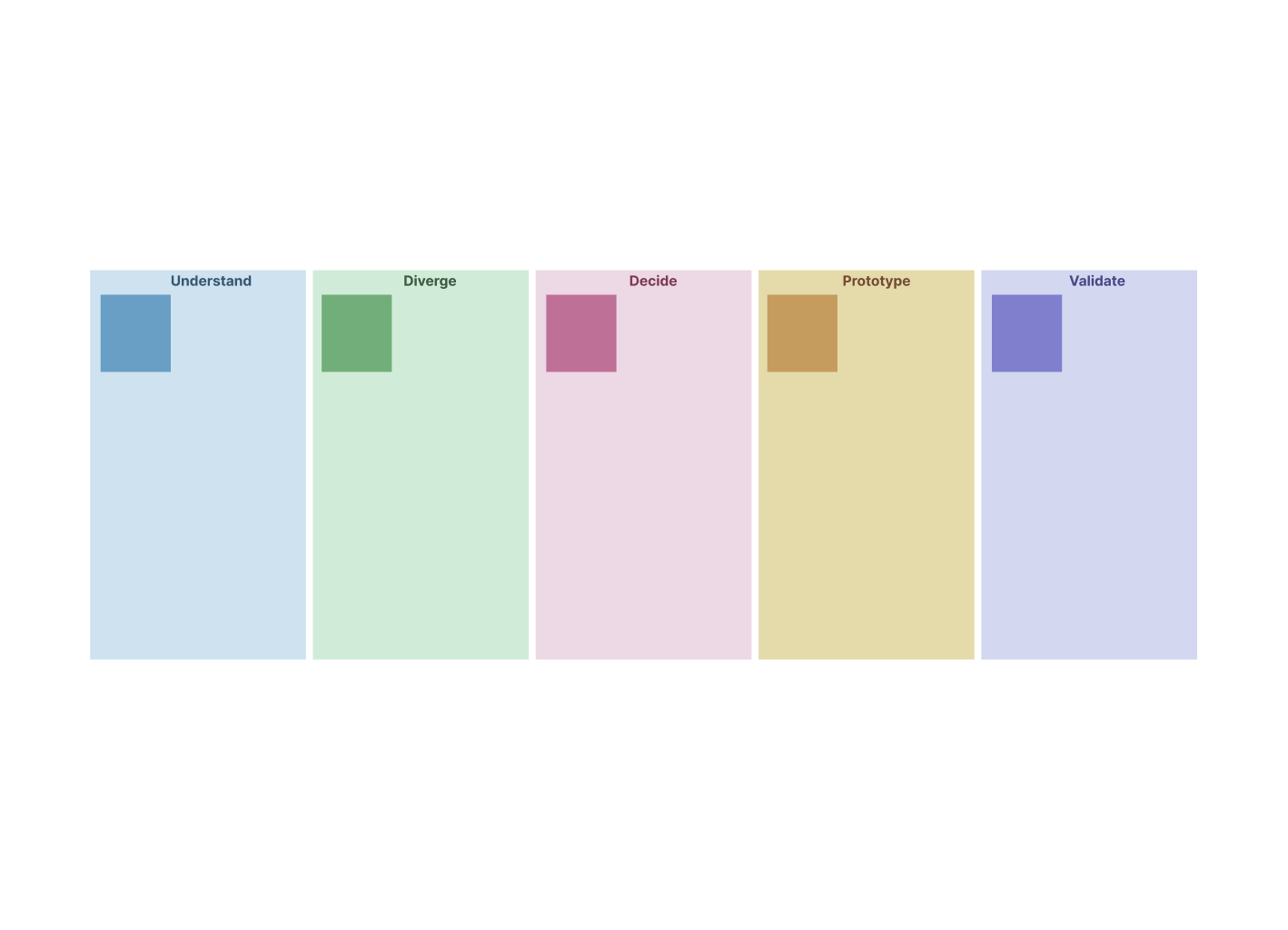A design sprint is a fast, focused way for teams to solve problems and test ideas in just a few days. Instead of spending months guessing or debating, a design sprint helps you build a prototype and get real user feedback quickly. It’s a popular method used by startups and big companies alike to reduce risk, save time, and make better decisions.
Design Sprint Definition
A design sprint is a structured five-day process that helps teams quickly solve problems, generate ideas, and test solutions with real users before heavy development. Created by Jake Knapp at Google Ventures, it guides cross-functional teams through understanding, sketching, deciding, prototyping, and testing—all within one week to speed up decisions and reduce risk.
What Happens in a Design Sprint
Here’s what typically happens during a design sprint:
1. A team is formed
The sprint team usually includes 5–7 people from different roles—design, product, development, marketing, and leadership. One person acts as the facilitator, guiding the team through the process.
2. The challenge is clearly defined
Before the sprint begins, the team identifies a specific challenge or goal they want to focus on. This could be a new product idea, an improvement to an existing feature, or solving a user experience issue.
3. Everyone clears their schedule
During the sprint, team members set aside other work so they can fully focus. It’s an intense but rewarding experience, often lasting five full working days.
4. Each day has a purpose
Every day of the sprint is structured with a clear goal—from understanding the problem and exploring solutions to building and testing a prototype. The process moves fast, but it’s designed to build confidence and clarity. For a detailed breakdown of how to conduct a design sprint, refer to our guide on how to conduct a design sprint.
5. The team creates a prototype
Instead of building a full product, the team creates a realistic, clickable prototype—something that looks and feels real enough for users to test, but is much quicker and cheaper to build.
6. Real users give feedback
On the final day, the team puts the prototype in front of real users (usually 5 people). The goal is to observe how they interact with the solution and learn what works, what doesn’t, and what to improve.
7. The team walks away with answers
By the end of the sprint, the team has real evidence about which ideas are worth pursuing—and which ones aren’t. This helps them make smarter decisions about what to build next.
Design Sprint Principles
Now that you know what is a design sprint, let’s look at its principles.
1. Work together, not alone
The sprint brings people from different backgrounds into one room (or virtual space). This includes designers, product managers, developers, marketers, and stakeholders. Everyone contributes their expertise, which leads to better, more balanced solutions.
2. Focus on the user
Every decision in a design sprint is guided by the needs and behaviors of real users. Teams don’t guess—they test ideas with actual users to see what works and what doesn’t.
3. Time-box everything
Design sprints run on a strict schedule. Each task, from sketching ideas to testing them, is given a set amount of time. This creates urgency, reduces distractions, and keeps the team moving forward.
4. Start with problems, not solutions
Instead of jumping straight to ideas, a design sprint begins by deeply understanding the problem. Teams map out the challenge, identify goals, and look at what’s already known before thinking about solutions.
5. Get tangible fast
Ideas quickly turn into rough sketches, then into a working prototype. This helps teams avoid long debates and test real interactions instead of just concepts.
6. Test early to learn fast
Rather than waiting months to see if something works, a design sprint ends with real user testing. Feedback comes early, helping teams avoid wasted time and costly mistakes.
7. Decide with data, not opinions
Instead of relying on the loudest voice in the room, design sprints are built to gather real evidence. User feedback and structured decision-making replace guesswork and gut feelings.
Types of Design Sprints
Here are the main types of design sprints based on what you’re trying to achieve:
1. Product design sprint
This is the most common type. It helps teams design and test new product ideas or improve existing ones. You build a realistic prototype and test it with users to see what works and what doesn’t.
Use it when: You’re launching a new product or adding a feature and want quick user feedback before development.
2. Process sprint
This sprint focuses on fixing or improving internal processes, like hiring, onboarding, communication workflows, or project approvals. It helps teams identify pain points and design better ways of working.
Use it when: Your current process is slow, confusing, or causing delays—and you need a better system.
3. Vision sprint
A vision sprint helps teams explore big ideas and long-term goals. It’s about thinking ahead—imagining what the company or product could become and setting a clear direction.
Use it when: You’re entering a new market, creating a roadmap, or aligning leadership on a future strategy.
4. Strategy sprint
This sprint helps teams solve important business challenges and make high-level decisions. It combines research, brainstorming, and prioritization to create a focused plan of action.
Use it when: You need to develop a new business strategy, respond to market changes, or set priorities for growth.
5. Brand sprint
A brand sprint is all about identity and messaging. It helps define what a company stands for, how it looks, how it talks, and how it wants to be perceived by customers.
Use it when: You’re building a new brand, rebranding, or struggling with inconsistent messaging.
6. Remote design sprint
This is a version of any of the above sprints, but done entirely online. Teams use digital tools to collaborate, prototype, and test ideas from anywhere.
Use it when: Your team is distributed or working remotely, and you want the same focused sprint experience online.
Free Templates to Get a Head Start on Your Design Sprint
AI Design Sprint Temaplate
Eliminate setup delays by using Creately’s AI Design Sprint Template. Auto- generate a complete sprint framework in moments, then refine steps directly within the canvas.
5-Day Design Sprint Template
The 5-day design sprint template guides your team through each phase of the sprint—understand, ideate, decide, prototype, and test—in a structured, collaborative workspace. It helps you move from problem to validated solution quickly, with built-in tools for brainstorming, sketching, and gathering user feedback.
What Are the Key Roles in a Design Sprint
Here are the key roles in a design sprint:
Facilitator (Sprint Master): Leads the sprint, manages time, guides activities, and ensures the team follows the process while staying focused and productive.
Decider: The person with final decision-making authority—often a product manager or team lead—who resolves tough calls to keep the sprint on track.
Designer: Translates ideas into visual concepts, sketches solutions, and builds the prototype to create a realistic test experience.
Product Manager or Strategist: Provides the big-picture perspective, aligning the sprint challenge with business goals, customer needs, and overall product vision.
Engineer or Developer: Offers technical insights to ensure proposed solutions are feasible and suggests practical approaches during ideation and prototyping.
Marketing, Sales, or Customer Support Rep: Brings direct customer knowledge, helping the team understand user expectations, pain points, and real-world context.
User Researcher or Analyst (optional): Supports test planning and feedback analysis, making sure prototype testing focuses on key learnings and user insights.
References
Mendonça de Sá Araújo, C.M., Miranda Santos, I., Dias Canedo, E. and Favacho de Araújo, A.P. (2019). Design Thinking Versus Design Sprint: A Comparative Study. Design, User Experience, and Usability. Design Philosophy and Theory, pp.291–306. doi:https://doi.org/10.1007/978-3-030-23570-3_22.
Arce, E., Suárez-García, A., López-Vázquez, J.A. and Fernández-Ibáñez, M.I. (2022). Design Sprint: enhancing STEAM and engineering education through agile prototyping and testing ideas. Thinking Skills and Creativity, p.101039. doi:https://doi.org/10.1016/j.tsc.2022.101039.
FAQs About Design Sprint
How long does a design sprint usually last?
What are the pros and cons of a design sprint?
Pros:
- Fast decision-making: Compresses months of work into a few days with quick user feedback.
- Reduces risk: Helps validate ideas early before investing in development.
- Improves team alignment: Brings cross-functional teams together for focused collaboration.
- User-centered: Ends with real user testing for informed insights.
- Boosts creativity: Encourages bold thinking and innovation through a structured process.
Cons:
- Time-intensive: Requires full-time participation for several days.
- Not for every challenge: Best suited for big, focused problems—not minor fixes or technical work.
- May overlook long-term needs: Quick focus can miss broader strategy or system issues.
- Inconclusive results: Prototypes may lead to more questions, not final answers.
- Requires follow-up: Needs clear next steps after the sprint to turn insights into action.
What are common challenges in a design sprint and how can I overcome them?
- Lack of preparation: Define the problem clearly and gather research before the sprint.
- Unclear decision-making: Assign a decider to avoid delays.
- Wrong team mix: Keep teams small (5–7 people) with diverse roles.
- Time pressure: Stick to the schedule and focus on learning, not perfection.
- Remote collaboration issues: Use reliable tools, set clear rules, and keep sessions short.
- Lack of follow-through: End with clear next steps and share outcomes with stakeholders.
How is a design sprint different from regular meetings or brainstorming?
What is the history behind the design sprint?
Do I need a special facilitator to run a design sprint?
When to run a design sprint?
Run a design sprint when:
- You’re launching a new product, feature, or service
- A project feels stuck or lacks clear direction
- You need to make a high-impact decision quickly
- Time and resources are limited
- You want to reduce the risk before building
- You need cross-functional team alignment
- You’re redesigning an underperforming experience







